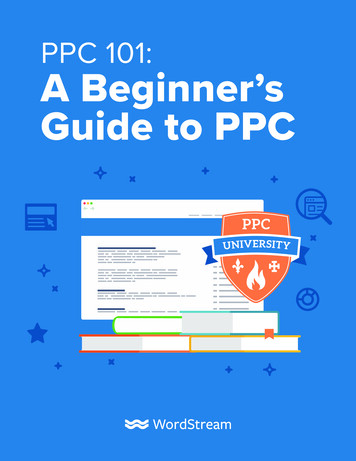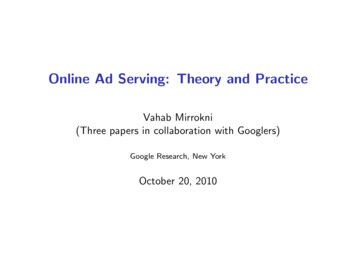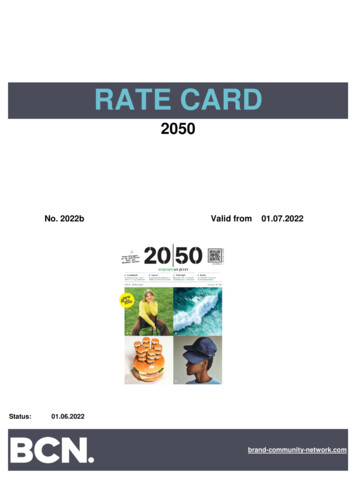
Transcription
ADS Chapter 534Personal Property Management OverseasPartial Revision Date: 06/19/2020Responsible Office: M/MS/OMDFile Name: 534 061920
06/19/2020 Partial RevisionFunctional Series 500 - Management ServicesADS 534 - Personal Property Management OverseasPOC for ADS 534: Annmarie McGillicuddy, amcgillicuddy@usaid.govTable of Contents534.1OVERVIEW . 3534.2PRIMARY RESPONSIBILITIES . 3534.3POLICY DIRECTIVES AND REQUIRED PROCEDURES . 5534.3.1Personal Property Management . 5534.3.2Standardization of Equipment . 6534.3.3Receipt of Personal Property . 9534.3.4Control of Personal Property . 9534.3.5Accounting for Personal Property. 9534.3.6Physical Inventory and Reconciliation . 10534.3.7Disposal of Personal Property . 10534.3.8Use and Control of Official Vehicles . 11534.3.9Report Requirements . 11534.4MANDATORY REFERENCES . 12534.4.1External Mandatory References . 12534.4.2Internal Mandatory References . 13534.5ADDITIONAL HELP . 14534.6DEFINITIONS . 14Text highlighted in yellow indicates that the adjacent material is new or substantively revised.ADS Chapter 5342
06/19/2020 Partial RevisionADS 534 - Personal Property Management Overseas534.1OVERVIEWEffective Date: 05/14/2009This chapter provides the Agency's policy directives and required procedures governingthe management, accountability, utilization, maintenance, and disposal ofadministratively controlled personal property overseas under direct USAID control.Personal property consists of such items as office and residential furniture, equipment,supplies, appliances, vehicles, and machinery. It refers to all property not otherwiseclassified as land, land improvement, buildings, and structures that are normallyreferred to as real property. Policy and procedures pertaining to the management ofUSAID official vehicles are located in ADS Chapter 536. Policy and procedurescovering real property management can be found in ADS Chapter 535.This chapter applies only to USAID Missions that provide their own administrativeservices (operating expense (OE) and program funded) or those that are USAIDAlternate Service Provider (ASP) Missions and provide personal property services toother Government agencies. USAID missions that receive personal propertymanagement services through the ICASS system, a program through which the U.S.Government (USG) provides and shares the cost of common administrative support atposts overseas, must adhere to Volume 6, Foreign Affairs Handbook (6 FAH-5),ICASS Handbook; 14 FAM 410, Personal Property Management for Posts Abroad;and post-specific guidance.This chapter does not apply to trust-funded or program-funded assets acquired undercontracts, grants, and cooperative agreements that are under the custody and control ofcontractors (see FAR 45, AIDAR 745.106, ADS 627 and 15 FAM 521.5).534.2PRIMARY RESPONSIBILITIESEffective Date: 06/19/2020a.The Director, Bureau for Management, Office of Management Services,Overseas Management Division (M/MS/OMD), is the designated Agency PropertyManagement Officer (PMO) for worldwide Agency overseas property. (See 14 ForeignAffairs Manual (14 FAM) 411.2-1, Property Management Officer (PMO) for a fulldescription of duties.)b.The Bureau for Management, Office of Management Services (M/MS) isresponsible for Setting USAID policies for overseas personal property management and creatingdirectives to implement them; monitoring compliance by overseas Missions withthe policy directives and procedures in this chapter;Text highlighted in yellow indicates that the adjacent material is new or substantively revised.ADS Chapter 5343
06/19/2020 Partial Revision Compiling property reports required by these regulations (see ADS 534.3.9) and14 FAM; Responding to requests from overseas posts needing assistance with personalproperty; for example, policy inquiries, reporting instructions, inventory systemproblem resolution, training of Mission property management staff, etc.; Advising posts on redistribution of personal property; Approving Mission standardization requests; and Approving Missions' requests to classify property for disposal as foreign excess.c.USAID Mission Principal Officers are responsible for implementing all policiesand procedures relating to USAID personal property at the Mission.d.Executive Officers (EXOs) are responsible for assisting Mission Directors inadministering the USAID personal property program at posts, to include assuming theduties of Mission Property Management Officer (PMO). (See 14 FAM 411.2-1, PropertyManagement Officer (PMO), for a full description of duties.)e.The Accountable Property Officer (APO) is responsible for all personalproperty duties. (See 14 FAM 411.2-2, Accountable Property Officer (APO), for a fulldescription of duties.)f.The Property Disposal Officer (PDO) is responsible for overseeing propertydisposal functions. (See 14 FAM 411.2-3, Property Disposal Officer (PDO), for a fulldescription of duties.)g.In overseas locations where personal property services and the combined assetsof agencies under Chief of Mission (COM) authority are consolidated under a singleshared administrative services structure, the responsibilities of the Alternate ServiceProvider agency and the Owning agency are specified in 2006 State ALDAC cable71874, dated 5/5/06.h.The USAID Controller is responsible for establishing policy and procedures forthe financial accounting of USAID personal property in accordance with all currentfinancial management regulations. (See 14 FAM 411.2-5, USAID Controller.)i.The USAID Regional Inspector General for Audit (RIG/A) is responsible forapproving the acquisition of RIG/A-funded personal property and assisting in theinventory of RIG/A-purchased property. (See 14 FAM 411.2-6, USAID RegionalInspector General for a full description of duties.)j.The Director, Office of Security (SEC) is responsible for designing, developing,and implementing property management policies, guidelines, and programs for allText highlighted in yellow indicates that the adjacent material is new or substantively revised.ADS Chapter 5344
06/19/2020 Partial Revisionsecurity property procured with security appropriated funds or Department of Statefunds earmarked for USAID. The Mission EXO becomes responsible for all securityproperty once it is issued from USAID/Washington (USAID/W) to the post.k.The Chief Information Officer (CIO) is responsible for issuing, designing,developing, and implementing property management policies, guidelines, and programsapplicable to information technology (IT) hardware and software.l.The Bureau for Management, Office of the Chief Financial Officer, CentralAccounting and Reporting Division (M/CFO/CAR), is responsible for issuing datacalls for capitalized assets to record in USAID’s general ledger and to ensure thefinancial statements are properly presented for capitalized property, plant, andequipment.m.The Office of Acquisition and Assistance (M/OAA) is responsible for issuingAgency-wide policies and guidelines for property management under contracts andassistance instruments (grants and cooperative agreements) awarded by bothUSAID/W and overseas operations.n.The Office of Acquisition and Assistance, Transportation Division,Commodity Logistics Team (M/OAA/T) is the USAID office responsible for USAID’sLimited Excess Property Program. M/OAA/T administers the Limited Excess PropertyProgram (LEPP), authorized and mandated by the Foreign Assistance Act (FAA),Sections 607 and 608. (See Contract Information Bulletin 98-26 for moreinformation about the LEPP.)o.The Bureau for Humanitarian Assistance (BHA) is responsible for theacquisition and control of items purchased with BHA funds. (See 14 FAM 411.2-7,Office of U.S. Foreign Disaster Assistance for a full description of duties.)p.Employees are responsible for personal property in their custody. (See 14 FAM411.2-9, Employee)534.3POLICY DIRECTIVES AND REQUIRED PROCEDURES534.3.1Personal Property ManagementEffective Date: 05/14/2009The Uniform State/USAID Regulations contained in 14 FAM 410- 417, PersonalProperty Management for Posts Abroad, are the governing directives for USAID'soverseas personal property program, as specified in this ADS chapter.If there is a conflict in instructions between the two directives, the following USAIDspecific policies supersede 14 FAM 410-417. Related regulations exist in ADS 629,Accounting for USAID-Owned Property and Internal Use Software.a.Personal Property ExceptionsText highlighted in yellow indicates that the adjacent material is new or substantively revised.ADS Chapter 5345
06/19/2020 Partial RevisionThe Agency Property Management Officer (PMO) grants exceptions to the propertymanagement regulations contained in this chapter and in 14 FAM 400 (410-417) on acase-by-case basis.b.Requirements for the Planning and Use of Personal PropertyThe Agency must adhere to the policies and procedures outlined in 14 FAM 412,Requirements Planning and Use.534.3.2Standardization of EquipmentEffective Date: 07/01/2007Standardization is the selection of a specific brand of technical equipment to theexclusion of other brands when it can be established that such action is necessary or inthe public interest. The standardization of equipment must comply with the followingprinciples and requirements:a.Standardization ProgramMissions are responsible for requesting the establishment or renewal of astandardization program. Missions must comply with the program once it isestablished and must periodically review it.b.Standardization AuthorityThe authority to approve a Mission standardization plan rests with the Director,M/MS for OE-funded equipment or equipment under USAID's control, or theContracting Officer for contractor-procured property to be used by the contractorduring contract performance.c.Standardization LimitationsThe authority to standardize must not be used for the purpose of selecting theequipment of certain suppliers or for the initial procurement of equipment andspare parts. However, at posts where other agencies have in place a valid andcurrent standardization plan for the same requirement as USAID's, and whereUSAID will benefit from joint effort with those agencies, the USAID Mission mayuse that standardization plan as a justification for requesting standardizationauthority for an initial procurement.The standardization authority must not be used until the Agency has determinedthat The equipment is considered technical. Technical equipment is definedas mechanical and electrical equipment with parts subject to wear throughText highlighted in yellow indicates that the adjacent material is new or substantively revised.ADS Chapter 5346
06/19/2020 Partial Revisionuse. Examples of items that may be considered for standardization aremotor vehicles, office and shop machines and equipment, unitizedfurniture, and household appliances; and d.The standardization of such equipment and interchangeability of its partsis necessary in the public interest.Request for StandardizationWhen establishing or amending a standardization program for property that istitled to USAID or under USAID's control, Missions must send a Request forStandardization to M/MS, or to the Contracting Officer when the property isprocured by a contractor for use under the contract. The request must beprepared in memorandum format and signed by the Mission PMO.The request must clearly state that standardizing a specific brand name, product,or feature of a product peculiar to one manufacturer is essential and thecompelling reasons why such standardization is necessary. The request mustinclude an analysis of the local conditions and the following information asapplicable:1.The name of the brand(s) to be standardized;2.A qualitative justification for the desired brands and models;3.A quantitative justification for the desired brands and models;4.A statement of continuing need;5.A historical review of existing equipment, detailing maintenance,repairs, and operation records of various brands and models in use;6.The availability of spare parts and maintenance facilities from localcommercial sources or other sources – When adequate commercial maintenance facilities are notavailable, the most suitable brand of equipment desirable forstandardization and why; When commercial facilities are available, the capabilities of thosefacilities for servicing one or more brands of equipment and theimpact these commercial capabilities have on the desired extent ofstandardization;7.A description of the terrain, altitude, and climatic conditions, if any,that impact on the selection of a specific brand or model; andText highlighted in yellow indicates that the adjacent material is new or substantively revised.ADS Chapter 5347
06/19/2020 Partial Revision8.e.The predominant model of any one brand now in use.Joint Standardization ProgramsMissions must make an effort to create a joint standardization program with otherU.S.G. agencies. When a standardization program has already been put intoeffect at a post, Missions must continue using the program if it is current andmeets USAID's requirements, thereby benefiting from the research that hasalready been done and the experience of the using agency.The Mission must submit a Request for Standardization to M/MS to participate ina joint program. The request must be prepared in memorandum format andsigned by the Mission PMO. It must include:1.A statement of joint effort with other U.S.G. agencies; and2.Other Government agencies' use of or experience with similarbrands and models. This information shows the possible availability andexchange of parts, or possible use of the other agencies’ skilled servicingemployees.f.Procurement Under a Standardization ProgramAll procurements made pursuant to the approved standardization program mustbe accomplished in accordance with applicable Federal Acquisition Regulation(FAR) and USAID Acquisition Regulations (AIDAR). Approval of astandardization plan is not in itself authority for Missions to procure standardizedequipment brands without full and open competition. The use of an existingexception to full and open competition is necessary for the procurement ofapproved standardized items, including U.S.-produced vehicles.The existing exceptions that Missions must use are found either in the authority48 CFR Chapter 7 (Subpart 706.302-70) or the procedures in FAR part 13 forpurchases under the simplified acquisition threshold. A class justification hasbeen approved to facilitate use of the authority in 48 CFR Chapter 7 (Subpart706.302-70) for local procurements; non-local purchases still require a separatejustification and approval in accordance with FAR 6.202, Establishing orMaintaining Alternative Sources. USAID has approved a class justification tofacilitate use of the authority in 48 CFR Chapter 7 (Subpart 706.302-70) forprocurements by Missions of U.S.-produced vehicles (see ADS 302.3.4.1.b.(2)).Procurement personnel must also comply with the requirements of ContractInformation Bulletin (CIB) 97-16, or updated revisions, when using these classjustifications.Text highlighted in yellow indicates that the adjacent material is new or substantively revised.ADS Chapter 5348
06/19/2020 Partial RevisionUSAID rarely awards procurements under the authority of FAR 6.302-1, OnlyOne Responsible Source and no Other Supplies or Services Will Satisfy theAgency Requirements. This authority is generally not appropriate. The level ofjustification required to convincingly demonstrate that only one source isavailable under a standardization program, together with other administrativerequirements as listed in FAR 6.302-1, make it suitable for use only inextraordinary cases.g.Standardization PeriodThe approved standardization period must be for a stated period of time bearinga reasonable relationship to the item's life expectancy. This period must notexceed six years. The approved program is subject to periodic reviews, and, ifconditions warrant, the standardization program must be revised or terminated.h.Standardization ExceptionsThe Executive Officer (EXO) at post must send requests for exceptions toestablished standardization plans to the Chief, M/MS for property that is to betitled to USAID or under USAID's control, or to the Contracting Officer when theproperty is procured by a contractor for use under the contract. Requests mustbe in writing and fully documented.534.3.3Receipt of Personal PropertyEffective Date: 05/27/2005The Agency must adhere to the policies and procedures in 14 FAM 413, PropertyReceipt.534.3.4Control of Personal PropertyEffective Date: 05/27/2005The Agency must adhere to the policies and procedures in 14 FAM 414, Control ofPersonal Property.534.3.5Accounting for Personal PropertyEffective Date: 05/14/2009The Agency must adhere to the policies and procedures in 14 FAM 415, Accounting,and ADS 629, Accounting for USAID-Owned Property and Internal Use Software.USAID Missions’ Accountable Property Officers must account for and track all propertythat meets the criteria as contained in 14 FAM 411.4 and 14 FAM 414.1-1 in propertyrecords/systems. (See 14 FAM 411.4 for definitions of nonexpendable personalproperty and accountable property.)Text highlighted in yellow indicates that the adjacent material is new or substantively revised.ADS Chapter 5349
06/19/2020 Partial RevisionSensitive and pilferable property, regardless of acquisition cost and procurementmethod, must be inventoried and tracked (see 14 FAM 414.1-1a.(9)). Sensitive andpilferable property is defined as durable assets that are readily portable and havesignificant resale value or significant potential for diversion to personal use. Examplesinclude, but are not limited to, cell phones, two-way mobile radio systems, satellitephones, digital cameras, personal digital assistants (PDAs), IPods, MP3 players, GPSdevices, special purpose flashlights, digital storage devices, televisions, DVD playersand protective clothing. Such assets require inventory controls regardless of acquisitioncost.534.3.6Physical Inventory and ReconciliationEffective Date: 05/14/2009The Agency must adhere to the policies and procedures in 14 FAM 416, PhysicalInventory and Reconciliation.Annual certification requirements and limitations on furnishings authorized for USAIDPrincipal Officers are specified in 15 FAM 772.2, USAID Mission Director’sResidence, and 15 FAM Exhibit 732a, China, Glassware, Silverware, KitchenUtensils and Linens authorized for USAID Principal Officers.534.3.7Disposal of Personal PropertyEffective Date: 05/05/2006a.Disposal of OE-Funded PropertyFor disposal of OE-funded property, the Agency must adhere to the policies andprocedures in 14 FAM 417, Disposal of Personal Property, and ADS 629.3.7,Depositing Proceeds from Real and Replacement Property Sales, on returning theproceeds of sales to the Mission.b.Disposal of USAID Program-Funded Property under Direct USAID ControlProgram-funded implementing awards (for example, contracts, grants, and cooperativeagreements) typically include a clause or provision to provide disposal instructions, andMissions must observe such provisions. If no specific ownership or disposalinstructions are included in the award, when the property is no longer needed for theimmediate purpose for which it was procured, the obligation official (such as theContracting Officer or the Agreement Officer) must instruct the contractor or recipient todispose of the property using the following order of precedence:1.Transfer to other uses within the Assistance Objective than that for whichit was originally purchased;2.Transfer to other programmatic uses within the country or region originallyserved by the relevant activity (Grant-in-Aid, Project Contribution, or donationprocedures apply);Text highlighted in yellow indicates that the adjacent material is new or substantively revised.ADS Chapter 53410
06/19/2020 Partial Revision3.Redistribution within USAID for administrative (OE) uses when such usesare expected to last one year or more (see 14 FAM 417.2-1, RedistributingReplacement Property);4.Transfer to another Government agency. In such cases, the receivingagency reimburses the USAID program account from which the property waspurchased, if such an account is active. The reimbursement must not exceed thefair market value of the property item;5.Sale by sealed bid or public auction, with the proceeds of sale beingcredited to the relevant programmatic account, if active. In the event theaccounts are inactive, for example, if a program has been closed, the proceedsmust be returned to the U.S. Treasury;6.Abandonment or cannibalization. These methods are used only when theProgram Manager has determined that the property has reached a condition ofnegligible value.c.Personal Property Transfers to Shared Administrative Support Structuresand/or ICASSUSAID personal property transferred to posts’ shared administrative supportstructures and/or to ICASS as part of the Federal initiative to right-size theGovernment’s presence abroad, and corresponding co-location of USGpersonnel under Chief of Mission (COM) authority into new embassy compound(NEC) facilities, is handled in accordance with 2006 State ALDAC cable 71874,dated 5/05/2006.534.3.8Use and Control of Official VehiclesEffective Date: 5/18/2009The Agency must adhere to the policy and procedures contained in ADS 536 and 14FAM 430.534.3.9Report RequirementsEffective Date: 05/14/2009The Agency must adhere to the reporting requirements established in 14 FAM and inADS 629, Accounting for USAID-Owned Property and Internal Use Software. (See534.4.1 for the specific 14 FAM guidance.) USAID/W (M/MS) will notify Missions via aworldwide message of the requirement to submit Mission-specific annual propertyreports (for example, the Mission Director’s Residential Inventory; the USAID MissionNonexpendable Inventory; and the GSA Sales/Exchange Report) to M/MS to facilitateUSAID headquarter external reporting requirements. USAID Mission EXOs must reviewand approve such reports before they transmit them to M/MS. In locations whereUSAID Missions obtain personal property services via the joint shared servicesText highlighted in yellow indicates that the adjacent material is new or substantively revised.ADS Chapter 53411
06/19/2020 Partial Revisionplatform, EXOs are responsible for collecting required reports/data from the serviceprovider and approving the reports prior to transmittal of data to M/MS.534.4MANDATORY REFERENCES534.4.1External Mandatory ReferencesEffective Date: 05/14/2009a.14 FAM 410, Personal Property Management for Posts Abroadb.14 FAM 416.3d., USAID Principal Officers Residencesc.15 FAM, Exhibit 732A, Representational Items Authorized for USAIDMission Directorsd.15 FAM 736.2e.15 FAM 772.2, USAID Mission Director Residencesf.41 CFR 101-38, Motor Vehicle Management (Authority)g.2006 State Cable 71874, dated 5/5/06 ICASS Shared Services AssetTransfer, Ownership, Title and Use Policyh.Federal Acquisition Regulation (FAR) 6.202, Establishing or MaintainingAlternative Sourcesi.Federal Acquisition Regulation (FAR) 6.302-1, Only One ResponsibleSource and No Other Supplies or Services Will Satisfy the AgencyRequirements.j.Federal Acquisition Regulation (FAR) Part 45, Government Propertyk.Federal Property and Administrative Services Act of 1949, as amended(Authority)l.Foreign Assistance Act, as amended, Sec. 636 a (5)&(9) and b; and 621(a)(Authority)m.General Accounting Office (GAO) Policy and Procedures Manual forGuidance of Federal Agencies, Title 2 (Authority)n.Joint Management Council (JMC)o.Reporting Requirements: See the Following ReferencesText highlighted in yellow indicates that the adjacent material is new or substantively revised.ADS Chapter 53412
06/19/2020 Partial Revision1. ADS 629, Accounting for USAID-Owned Property and Internal UseSoftware2. 14 FAM 413, Property Receipt3. 14 FAM 415.2-3, Coordination of Property and Fiscal AccountingRecords4. 14 FAM 416.2, Physical Inventory and Reconciliation5. 14 FAM 416.3d., USAID Principal Officers Residences6. 14 FAM 416.4, Reconciling the Annual Inventory7. 14 FAM 417.3, Methods of Disposal8. 14 FAM 418.2, Sale or Exchange Reporting9. 14 FAM 418.3, Capitalized Property Records10. 15 FAM 732A, 15 FAM 732 A Exhibit A11. 15 FAM 736.2p.State 6 FAH-5 ICASS Handbook (H-400 Series)534.4.2Internal Mandatory ReferencesEffective Date: 05/14/2009a.48 CFR Chapter 7 (Subpart 706.302-70), Impairment of Foreign AidProgramsb.48 CFR Chapter 7 (Subpart 745)c.ADS 535, Real Property Management Overseasd.ADS 536, Use and Control of Official Vehiclese.ADS 629, Accounting for USAID-Owned Property and Internal Use Softwaref.Contract Information Bulletin (CIB) 97-16, Class Justification for Use ofOther Than Full and Open Competition for Personal Services Contractswith U.S. Citizens Contracted with Locally, with CCNs and TCNs Subject tothe Local Compensation Plan, and for Overseas Contracts of 250,000 orLessText highlighted in yellow indicates that the adjacent material is new or substantively revised.ADS Chapter 53413
06/19/2020 Partial Revision534.5ADDITIONAL HELPEffective Date: 05/14/2009There are no Additional Help documents for this chapter.534.6DEFINITIONSEffective Date: 05/14/2009The terms and definitions listed below have been incorporated in the ADS Glossary.See the ADS Glossary for all ADS terms and definitions.accountable property (See definition contained in 14 FAM 411.4)Accountable Property Officer (APO)An official appointed by Agency Property Management Officers who is responsible fornonexpendable property or information technology (IT) property. The IT APO isseparately designated by IRM. This official is charged with budgeting, accountability,receipt, storage, issuance, record keeping, inventory, reporting, and certification of allproperty resources records and reports within the accountable area. For IT propertythis pertains to all Federal Information Processing (FIP) resources. (Chapters 518,532, 534, 547, 629)administrative propertyAdministrative property is basic common-use furniture, furnishings, and equipment(including residence property) usually available through normal supply channels (e.g.,desks, chairs, office machines, sofas, beds, refrigerators, etc.). (Chapter 534)Assistance Objectives (AOs)The most ambitious result that a USAID Operating Unit, along with its partners, canmaterially affect, and for which it is willing to be held accountable). (Chapters 200, 534)capitalized personal propertyCapitalized personal property is nonexpendable personal property that has an invoicecost of 25,000 or more and an estimated service life of two years or longer that mustbe capitalized and reported on in the Agency's financial statements. State vehicles arecapitalized property regardless of cost. For USAID, vehicles with a basic acquisitioncost of under 25,000, including shipping costs, are not capitalized. (Chapters 518,534, 547)fair market valueFair market value is the monetary value that an agency could reasonably expect toreceive for an asset in a current sale between a willing buyer and a willing seller otherthan in a forced or liquidation sale. (Chapter 534)foreign excess personal propertyForeign excess personal property is property located in a foreign country, and under thecontrol of a Federal agency or designee, no longer needed locally, and determined byText highlighted in yellow indicates that the adjacent material is new or substantively revised.ADS Chapter 53414
06/19/2020 Partial Revisionthe head of the agency that it is no longer required by the agency elsewhere.Establishments abroad are not to use the word "surplus" on disposal documentsbecause this term is reserved for GSA use. This form is very rarely used by USAID forOE-funded property. (Chapter 534)International Cooperative Administrative Support Service (ICASS)The International Cooperative Administrative Support Services (ICASS) system is theprincipal means by which the U.S. Government provides and shares the cost ofcommon administrative support at its more than 250 diplomatic and consular postsoverseas. The Department of State is the primary service provider and it offers theseadministrative support services to other agencies under its non-Economy Act authoritiescontained in 22 USC 2695 and 2684. ICASS is, for the most part, a voluntary system.Agencies select from a list of cost centers (which are “bundles” of services) whichservices they would like to receive via the ICASS system. Agencies may obtainservices from non-ICASS sources or self-provide services as long as there is noduplication of the ICASS platform. (Chapters 520, 527, 533, 534, 635)inventoryInventory is a physical count performed to determine the on-hand quantity of an item orgroup of items. (Chapter 534)invoice costThe total of the amount paid to the vendor, including related costs, such as,transportation or installation, if included on the vendor’s initial invoice. (Chapter 534)nonexpendable personal property (See definition contained in 14 FAM 411.4)personal propertyPersonal property includ
534.3 POLICY DIRECTIVES AND REQUIRED PROCEDURES 534.3.1 Personal Property Management Effective Date: 05/14/2009 The Uniform State/USAID Regulations contained in 14 FAM 410- 417, Personal Property Management for Posts Abroad, are the governing directives for USAID's overseas personal property program, as specified in this ADS chapter.










